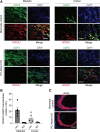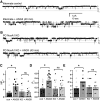NOXA1-dependent NADPH oxidase 1 signaling mediates angiotensin II activation of the epithelial sodium channel
- PMID: 36201326
- PMCID: PMC9705023
- DOI: 10.1152/ajprenal.00107.2022
NOXA1-dependent NADPH oxidase 1 signaling mediates angiotensin II activation of the epithelial sodium channel
Abstract
The activity of the epithelial Na+ channel (ENaC) in principal cells of the distal nephron fine-tunes renal Na+ excretion. The renin-angiotensin-aldosterone system modulates ENaC activity to control blood pressure, in part, by influencing Na+ excretion. NADPH oxidase activator 1-dependent NADPH oxidase 1 (NOXA1/NOX1) signaling may play a key role in angiotensin II (ANG II)-dependent activation of ENaC. The present study aimed to explore the role of NOXA1/NOX1 signaling in ANG II-dependent activation of ENaC in renal principal cells. Patch-clamp electrophysiology and principal cell-specific Noxa1 knockout (PC-Noxa1 KO) mice were used to determine the role of NOXA1/NOX1 signaling in ANG II-dependent activation of ENaC. The activity of ENaC in the luminal plasma membrane of principal cells was quantified in freshly isolated split-opened tubules using voltage-clamp electrophysiology. ANG II significantly increased ENaC activity. This effect was robust and observed in response to both acute (40 min) and more chronic (48-72 h) ANG II treatment of isolated tubules and mice, respectively. Inhibition of ANG II type 1 receptors with losartan abolished ANG II-dependent stimulation of ENaC. Similarly, treatment with ML171, a specific inhibitor of NOX1, abolished stimulation of ENaC by ANG II. Treatment with ANG II failed to increase ENaC activity in principal cells in tubules isolated from the PC-Noxa1 KO mouse. Tubules from wild-type littermate controls, though, retained their ability to respond to ANG II with an increase in ENaC activity. These results indicate that NOXA1/NOX1 signaling mediates ANG II stimulation of ENaC in renal principal cells. As such, NOXA1/NOX1 signaling in the distal nephron plays a central role in Na+ homeostasis and control of blood pressure, particularly as it relates to regulation by the renin-ANG II axis.NEW & NOTEWORTHY Activity of the epithelial Na+ channel (ENaC) in the distal nephron fine-tunes renal Na+ excretion. Angiotensin II (ANG II) has been reported to enhance ENaC activity. Emerging evidence suggests that NADPH oxidase (NOX) signaling plays an important role in the stimulation of ENaC by ANG II in principal cells. The present findings indicate that NOX activator 1/NOX1 signaling mediates ANG II stimulation of ENaC in renal principal cells.
Keywords: collecting duct; hypertension; reactive oxygen species; renal physiology; sodium excretion.
Conflict of interest statement
M.S.R. is a member of the Board of Directors at Eli Lilly & Company. None of the other authors has any conflicts of interest, financial or otherwise, to disclose.
Figures







References
Publication types
MeSH terms
Substances
Grants and funding
LinkOut - more resources
Full Text Sources
Molecular Biology Databases
Research Materials
Miscellaneous

